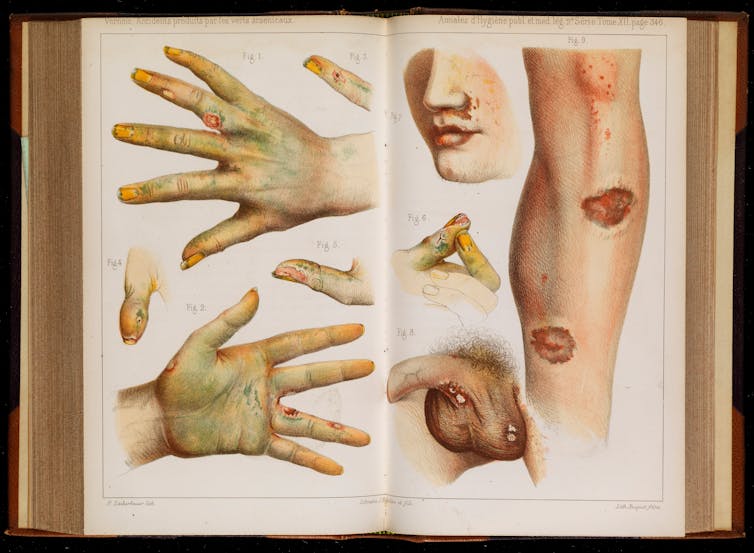Handle With Care Or Not At All
 |
"One of the most dangerous books ever created was meant to warn against exactly this danger [arsenic used for commercial purposes]."
"In the 1870s, an American doctor tried to raise awareness of the hazards of arsenic-laced wallpaper by creating a book of potentially poisonous samples and sending it around the libraries. The intent was to help people identify dangerous wallpaper in their homes, not to poison librarians."
"Today, only four copies of that book still exist, and they're treated very carefully."
Atlas Obscura
"It is well documented that European bookbinders in the 16th and 17th centuries used to recycle older parchments."
Josh Povi Holck and Kanre Lund Rasmussan, Conversation
 |
Paris Green was a popular emerald pigment for Victorian paints and dyes. It was also chock-full of toxic arsenic.
Credit: Chris Goulet at English/ CC BY-SA 3.0
|
Arsenic is a metal which if ingested in sufficient proportions can kill. It is present in the Earth's crust. Volcanic action helps to spew it into the atmosphere where it falls to the ground; it is, quite literally, everywhere, including water. And at one time it was used commercially in paint, in clothing and even once was used as a dye for stamps which of course would be 'licked' by those using them to adhere to an envelope. Even once it became known that arsenic was a poisonous element and a morbid threat to human life, it was still being used throughout the 19th century.
By early the 20th century scientists acknowledged that when inhaled arsenic could have dangerous consequences when it off-gasses its poisonous attributes. At the University of Southern Denmark, books dating from the 16th and 17th centuries featuring various subjects were recently X-rayed as professors were searching to determine whether any old Latin texts held in the university's library had been used in the books' bindings, a kind of 'recycling' of materials that was not uncommon for earlier eras.
 |
| The Arsenic Waltz’. © Wellcome Collection, CC BY-SA |
What they discovered was that three texts's bindings were painted with green containing arsenic. A common device through to the 19th century; the use of green paint tinted with arsenic. After this surprise discovery, the books were isolated, each stored in a separate box well marked with safety warning labels to be placed in a well-ventilated cabinet. The intention now is for specialists to digitize the contents of each book so that henceforth physical handling will not be required to access their contents.
An obvious 21st century solution to a problem stemming from a far earlier era.
 |
A researcher (carefully) holds
one of the arsenic-poisoned books. The tome dates to the Renaissance,
but was likely coated in arsenic paint by misguided Victorians.
Credit: University of Southern Denmark/ The Conversation
|
"Arsenic is a naturally occurring element that’s found in soil and water. It has also been used by farmers as a pesticide and a fertilizer. It is also used to preserve pressure-treated wood.
Like lead, mercury, and other heavy metals, arsenic can persist in soil for years after it is applied to crops."
"Much of the rice grown in the Southern U.S., for example, grows in paddies that were once cotton fields. Cotton farmers are known to have used arsenic-based pesticides to control bugs called boll weevils."
"Other studies have shown that arsenic content in soil is higher around rivers and may be related to soil texture. Clay soils have more naturally occurring arsenic."
"Because of its chemical structure, plants mistake arsenic for necessary nutrients and readily absorb it from the soil."
WebMD
Labels: Arsenic, Bioscience, Health, Poison, Threats

0 Comments:
Post a Comment
<< Home